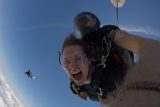“What if my parachute doesn’t work?” We hear that concern pretty much every day, as it’s one of the most common fears that brand-new skydivers face. Essentially, it boils down to fear of the unknown–so education is your best defense against the unnecessary nerves the question can cause. After all, most people don’t actually know how the parachute system works. After that first jump, most people’s nerves are settled because the experience has cleared them up on how the individual components work, what skydiving feels like, and just how trained professional skydivers are to handle the eventualities that may arise.
It takes two.
A modern parachute container system holds not one but two parachutes: a “main” and “reserve.” The reserve parachute is packed snugly into the top portion of the “container” (the ‘backpack,’ essentially) by an FAA-certified parachute rigger, who signs off on a full system inspection for each parachute every 180 days. The reserves are inspected and repacked whether or not they’ve been used. Skydiving rigs are always two-parachute systems–no matter what–and must cleave to the strict repacking schedule, or they’re decommissioned until they’re freshly inspected and repacked.
The reserve parachute is connected to the system in a pretty elegant way: in the event that it has to be deployed, it uses the drag of the departing main parachute to speed up the rate of the reserve deployment. The amount of time it takes the reserve parachute to deploy and fly is, in fact, usually pretty negligible.
Malfunctions are no mystery.
It’s actually pretty darn rare that the main parachute doesn’t function correctly, but skydivers are thoroughly prepared for that if it does manage to happen. When a parachute malfunction happens, the skydiver involved has been thoroughly trained to recognize what’s happening and how to resolve it.
Sometimes, the malfunction can be cleared by taking relatively simple action, without needing to go to the reserve parachute. In some cases, the skydiver must jettison the malfunctioning main parachute and deploy the reserve. That might sound like a big deal, but it actually isn’t. In fact, on the very rare occasions that this occurs during a tandem skydive, the student often doesn’t even know it happened until they’re safe on the ground. Sounds nuts, but it’s true!
Work that curiosity!
At any rate: When it comes to malfunctions, it’s the how that counts. When you’re brand-new to skydiving and don’t understand the procedures, the idea of a malfunction can be overwhelming. When you get into the sport and you understand how to identify malfunctions and how to execute the emergency procedures, it’s not nearly as frightening.
Curiosity about this is often the reason folks pop in to sign up for a solo skydiving course right after they land from that first tandem jump. If you’re nervous, it just means you have extra room to learn! We’d love to teach you all about the systems and procedures that make skydiving as safe, enjoyable and comfortable as it is in our modern era. To learn more about skydiving, contact Chattanooga Skydiving Company to learn more.





